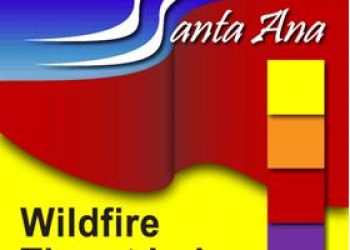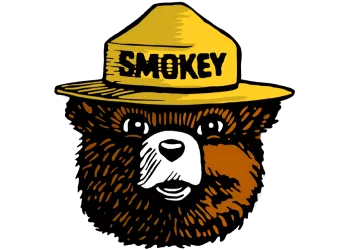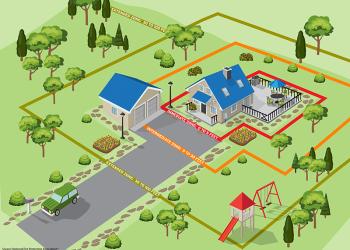Prevention
Campfire Permits
Campfire Permits are required year-round for the use of campfires, charcoal barbeques, gas stoves and lanterns outside of developed recreation areas. Permits are available free of charge and can be obtained online or by visiting any Forest Service, Bureau of Land Management or CAL FIRE office.
Developed recreation areas (such as designated campgrounds and picnic areas) tend to be well-marked and usually include a metal fire ring, a picnic table and a parking area. When in doubt, get a permit!
Campfire safety - Make sure your fire is dead out before you leave.
Charcoal Briquettes - After using barbeques, be sure to completely extinguish the burning charcoal briquettes: Soak the coals with lots of water; stir them and soak again. Be sure they are out cold! If the coals are too warm to touch, they are too warm to leave. Always double check!
Stoves, Lanterns and Heaters - Cool all stoves, lanterns and heaters before refueling. When filling, place them on the ground in a cleared area. If fuel spills, move the appliance to a new clearing before lighting it. Recap and store flammable liquid containers in a safe place. Never light lanterns or stoves inside a tent, trailer or camper. Always read and follow instructions provided by the manufacturer. Remember to properly dispose of used or empty fuel containers.
Fire Restrictions
Remember to check for current fire restrictions by calling ahead to the closest ranger station. Depending on conditions, certain restrictions may be placed on the use of campfires, charcoal barbeques and stoves within the forest. Even if you have a campfire permit that has not yet expired, you are still obligated to abide by current fire restrictions.
Equipment use - Did you know dragging chains on vehicles cause forest fires?
Practice fire-safe target shooting - Don't let target shooting end with a wildfire.
Off-Highway Vehicle (OHV) Use - When touring the forest in a vehicle (i.e. car, truck, SUV, quad, motorcycle, etc.) stay in designated areas and on established roads and trails. Be careful, and don't expose your vehicle's hot parts to dry vegetation. Even when travelling in designated areas, narrow trails and two-tracks may get brushy and dangerous. Catalytic converters, hot exhaust pipes, etc., can start wildfires if they come in contact with dry vegetation. Be careful when you explore and continually monitor your gauges and temperature.
Spark Arresters - Many types of equipment and off-road vehicles are required to have a USDA Forest Service approved spark arrester. Chainsaws, portable generators, all-terrain vehicles, and trail bikes are some examples of equipment requiring approved spark arresters to help prevent wildfires. To make sure a spark arrester is functioning properly, check with the equipment/vehicle dealer or contact your local Forest Service or State Forestry office.
Smoking - When smoking is permitted outdoors, safe practices and state law require at least a 3-foot clearing around the smoker. Grind out your cigarette, cigar or pipe tobacco in the dirt -- never grind it on a stump or log. It is unsafe to smoke while walking or riding a horse or trail bike. Use your ashtray while in your vehicle.
Reduce Risk
Communities can take steps to reduce and manage risk and become better fire-adapted. Find tools and resources to help mitigate wildfire risk in your community.
- Create a defensible space. This is the area between a house and an oncoming wildfire where the vegetation has been modified to reduce the wildfire threat and to provide an opportunity for firefighters to effectively defend the house.
- Use Firewise Landscaping to help create a defensible space around your home and increase your home's chance of surviving a wildfire. Choose fire-resistant building materials and maintain flammable vegetation in the home ignition zone of 100-200 feet surrounding the structure.
- Proper clearance dramatically increases the chance of your house surviving a wildfire. Defensible space also provides for firefighter safety when protecting homes during a wildland fire.
- Burn permits, which are required, are issued by your local, state, and federal fire agencies. Burn permits are only valid on "Permissive Burn Days" as determined by the State Air Resources Board or the local Air Pollution Control District. More information about burn permits
Related Links
Santa Ana Wildfire Threat Index - SAWTi

Only You Can Prevent Wildfires

Only you can prevent wildfires, and here’s how! While at home or on camping trips, follow these important safety tips.
CAL FIRE
Stay Safe and Stay Informed with firePLANNER
Forests and Rangelands
Safely and effectively extinguish fire when needed; use fire where allowable; manage our natural resources; and as a nation, to live with wildland fire.
Fire Prevention Information
Wildland Fire Information and Technology (WFIT)
The purpose of Wildland Fire Information and Technology (WFIT) is to promote interagency collaboration in the support of the business mission of the Wildland Fire Program. WFIT provides information and technology services and functions independent of agency or user location, thus providing a new level of flexible and adaptable technology for the users in the field.
Western Regional Strategy Committee eNewsletters
Check out the latest and archived Western Regional Strategy Committee eNewsletters on their website, as well other information related to the Western Region and the Cohesive Strategy.
The National Strategy: The Final Phase in the Development of the National Cohesive Wildland Fire Management Strategy
The National Cohesive Wildland Fire Management Strategy is a strategic push to work collaboratively among all stakeholders and across all landscapes, using best science, to make meaningful progress towards the three goals:
- Resilient Landscapes
- Fire Adapted Communities
- Safe and Effective Wildfire Response







